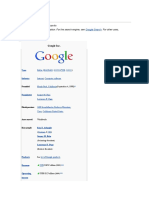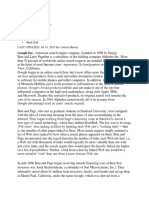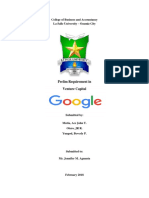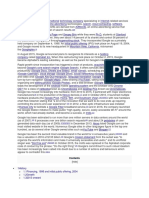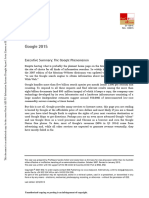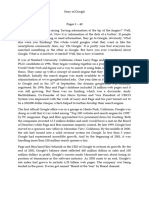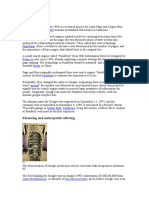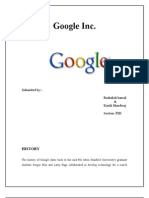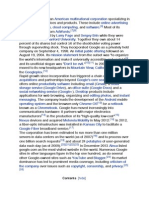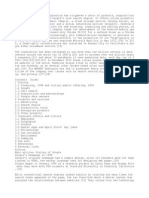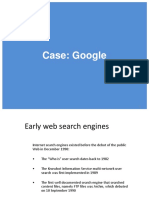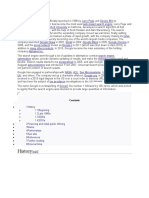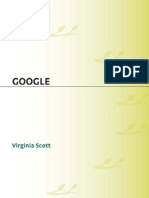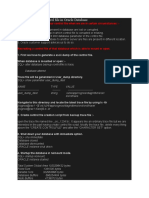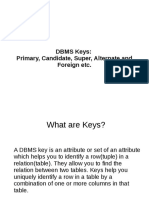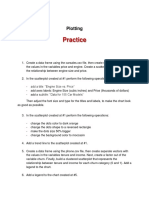HISTORY OF GOOGLE.
2
Hook
In our last video, you guys saw how Larry Page and Sergey Brin had teamed up to produce
project Backrub, a search engine that would later be called Google. Well, just uploading and
naming the project wasn’t the last thing that these two geniuses had to do, it was just the first
milestone in a long journey.
Intro
Welcome back to The Bearded Techie. On the 2 nd of the 5-video series Google: A Search
History, we are going to continue on with the story of Google and how it became the company
that it is today. So, grab a snack, smash that like button and lets get started.
Main Script
When we last left off, the initial Beta of Google had finally been uploaded to the Stanford
Website. Lets start from there.
Google gained popularity among a select group of Stanford students and faculty. Stimulated by
this, Brin and Page set out to enhance the service by indexing additional pages and enabling
full-text search. Almost immediately, they learned that search engines are quite demanding on
computer systems. They couldn't afford to buy new computers, so they took a hard drive from
the computer science department's network lab and an idle CPU from the computer science
department's loading docks to start the expansion of Google. They turned Page's dorm room
into a makeshift machine shop, cobbling together a computational Frankenstein out of scraps,
and then connecting it to Stanford's fiber-optic campus network. Their first stop was Brin's
dorm room, which they transformed into an office and programming hub after they had
finished stocking Page's room with their equipment.
�Within the realms of campus network administration and the computer science department,
the project became something of a myth. For an institution like Stanfords, with one of the best
networks in the world , the BackRub crawler once used up roughly half of all available
bandwidth. The project also had a habit of disrupting Stanford's Internet service on a regular
basis in the fall of 1996. Now many people would have been annoyed by this but according to
Page, there were many forward-looking people present at Stanford as they didn’t mind the
excess resources being consumed by the duo because they believed that Page and Brin were
going to change the world.
BackRub and Google's implementation of it were making waves as Brin and Page persisted in
their experimentation, both on the Stanford campus and in the often closed-off realm of
academic Web research.
Cornell professor Jon Kleinberg, who at the time was conducting research on bibliometrics and
search technologies at IBM's Almaden Research center in San Jose, was aware of Page and
Brin's work. Possibly second only to PageRank in popularity, Kleinberg's hubs-and-authorities
method for Web ranking is widely used. Kleinberg paid a visit to Page in the summer of 1997 at
Stanford for some friendly comparison. An early version of Google was demonstrated to
Kleinberg by Page after Kleinberg had finished writing his important paper, "Authoritative
Sources." It was Kleinberg's recommendation that Page writes a scholarly paper about
PageRank. Page expressed concern to Kleinberg about going public. So why would he think
that? Well, according to Kleinberg, "Page was worried that someone may steal his ideas, and he
felt like he had the secret recipe with PageRank."
Both Page and Brin were hesitant to embark on the challenges of establishing and maintaining a
business. Because of the loss of his father during his first year at Stanford, Page's friends say he
has considered completing his Ph.D. as a way to honor his memory. Brin, who had a similar
academic environment, was hesitant to drop out.
�Brin recalled their conversation in which his advisor told him, "I mean, if this Google thing works
out, that's cool and all. In such case, you can always go back to graduate school to finish off
your thesis." After a little pause, he says with a chuckle: "I said, "Yeah, whatever, why not?" OK,
I'm going to test it out."
Andy Bechtolsheim, the co-founder of Sun Microsystems, invested $100,000 in Google in
August 1998, before the company was even established. In the early months of 1999, while still
in school, Brin and Page abandoned their search engine because it was interfering with their
studies. They approached George Bell, CEO of Excite, with an offer to sell the company to him
for $1,000,000, which he declined. After negotiating the price down to $750,000, he rejected it
and went on to insult Excite investor Vinod Khosla.
After Page and Brin started Google, they brought in Eric Schmidt to lead the company in 2001.
Even though it had only been around for a short period of time, the company had already
outgrown its founders and was in need of "adult supervision," as Brin put it in a 2014 interview
with Charlie Rose. Schmidt came to Google with extensive experience in engineering, having
served as the chief technology officer (CTO) of Sun and the chief executive officer (CEO) of
Novell before joining the search giant.
In March of 2001, Eric became the chairman of the board of directors and in August of the same
year, he was promoted to chief executive officer. Over the course of his decade-long tenure,
Schmidt oversaw Google's IPO in 2004, the purchase of YouTube, and the launch of staples like
Google Docs and Gmail. When Page took over as CEO in 2011, Schmidt moved to the position of
executive chairman. He made the announcement in a witty tweet, writing, "Day-to-day adult
supervision no longer needed!"
�There was no doubt that Google's early 2000s would be a watershed period. Yahoo was the
most popular search engine online long before Google was even a concept. In 2000, as Google's
popularity grew, it was chosen to power Yahoo's search engine. According to reports, Google
turned down a $3 billion offer from Yahoo to acquire the search engine in the summer of 2002
because it believed it was worth at least $5 billion.
Later that year, Google introduced Google News, a content aggregation service that would
forever alter the way in which online news and other forms of digital media were disseminated.
Today, the combined market value of Google and its parent company, Alphabet, is $840 billion.
On the other hand, Verizon purchased Yahoo in 2017 for a price that was close to $5 billion.
When Google's Palo Alto and other Silicon Valley locations became too small, the company
moved its operations to the Amphitheatre Technology Center on Amphitheatre Parkway in
Mountain View, California, which was owned by Silicon Graphics at the time. The relocation was
made to suit Google's then-over-a-thousand-strong personnel. Due to numerous developments
and building acquisitions, this location is now the Googleplex, and it houses the majority of the
company's employees.
When it first went live to the public on April 1st, 2004, Gmail's 1GB of storage and extensive
search features far outstripped the capabilities of competing email programs, many of which
offered only a few megabytes. Many in the media assumed it was an April Fools' joke because
of the timing of its release. And it wasn't.
After bringing on Schmidt, Google took off like a rocket, quickly rising to the top of both the
tech industry and the broader American economic scene. With the $1.7 billion it raised in its
IPO in August of 2004, Google's market cap increased to $27 billion.
The fact that only Page, Brin, Schmidt, and a few other executives were granted so-called super-
voting Class B stock is one of the most prominent features of Google's initial public offering.
Class B shares had ten times the voting power of Class A shares, so Page and Brin kept hold of
�little over half of them to ensure they would always have control of the company, even after
they had left.
At the time, Page said that the decision was made to "maximize value in the long term," a
phrase that has since been adopted by a number of other prominent Silicon Valley companies,
including Facebook. That was an objective the founders worried would be jeopardized by the
concentration on short-term profits prompted by shareholder worries. The business structure
we're putting in place is made to last for decades. When you invest in Google, you're making a
"long-term investment on the team, notably Sergey and me, and on our innovative approach,"
as Page put it.
In the summer of 2005, Page spent $50 million to acquire a fledgling company by the name of
Android, based on one of his most astute financial predictions: the imminent rise of mobile
computing. Even though Schmidt was still CEO at the time, Page made the decision to hire
Android co-founder Andy Rubin without consulting him. Page was confident that Rubin could
help Google gain ground in the mobile software market.
It seemed inevitable that Android will eventually overtake iOS as the dominant smartphone OS.
As legend has it, Rubin famously saw Apple CEO Steve Jobs reveal the iPhone in 2007 on his
laptop while riding a cab in Las Vegas, prompting a last-minute course adjustment to the
project. It wasn't until the T-Mobile G1/HTC Dream was announced in 2008 that the first
Android phone was released into the wild, laying the groundwork for the first open-source
mobile operating system.
This was also the year in which Google would first launch Google Maps, now this wasn’t the
Google Maps that we know and love today, it was a much more basic version, one that would
need a fair amount of tweaking to fully be realized.
�Now at the start of 2006, Google launched its search engine in China. Although Google's
Chinese-language website had been available to Chinese customers since September 2000, the
service was headquartered in California and was difficult to load due to censorship and firewall
restrictions. Google established a local Chinese company in 2006 to better compete with Baidu.
A disclaimer was placed on top of the results, and they were extensively edited.
To cap this video off, lets talk for a second about Googles purchase of YouTube. In September of
1998 the 2 google co-founders set up office in Susan Wojcicki's parents garage. Susan helped
design the companies iconic logo and spearheaded the first launch of Google Doodles. In 2006,
She got the support of Google co-founders Larry Page and Sergey Brin, but had to persuade
upper management to spend $1.65 billion to acquire the online video service. Susan, who was
in charge of Google's own video platform when it was just getting started, saw YouTube as the
undisputed frontrunner early on in what would become a heated competition.
She needed to act quickly to secure the purchase while Google held the upper hand in price
negotiations. Measure What Matters is a book written by venture financier and tech
entrepreneur John Doerr about Susan's experience. For the 1.65 billion dollar purchase, "I
pulled up some figures to explain the price and convinced Larry and Sergey." Putting aside the
seemingly endless controversy surrounding YouTube as of late, it appears that taking Susan's
advice was the right move.
The story doesn’t end here as Google is just getting started, so join us in our next video to
follow Google’s journey to the top.
�Outro
That is all the time we have today folks, Thanks for tuning in, and I hope you
enjoyed the 2nd of this 5 video series Google: A Search History. Don’t forget
to subscribe to the channel if you haven’t already, smash that like button,
leave a comment down below and make sure you hit that notification bell
and set it to all so you don’t miss when video 3 gets uploaded or any other
video on this channel. Thanks again, and I catch you all on the next one.
